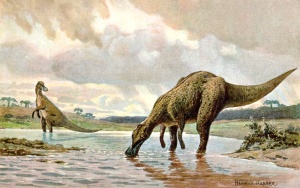
Hadrosaur
The perplexing classification was probably a result of the infamous period in paleontology history later known as Bone War. Edward Cope and Othniel Marsh, two pre-eminent paleontologist of the time, competed in terms of most sensational dinosaur they could find. The war was triggered by the discovery of nearly-complete skeleton ever find. To honor its founder William Foulke, it was given the name Hadrosaurus foulkii. Of course later on, an amazingly preserved complete hadrosaurid specimen was founded by Charles Sternberg and his sons in Wyoming, known as the “trachodon mummy”. This discovered helped Cope to win the competition.
Hadrosaurs lived in the Cretaceous period, about 84 to 71 million years ago. Hadrosaurs were the most common dinosaurs. Over ten thousands hadrosaurs’ fossilized bones were found in one site. Hadrosaurinae such as Edmontosaurus, Hadrosaurus, and Maiasaura, and Lambeosaurinae such as Corythosaurus, Lambeosaurus, and Parasaurolophus all various examples of Hadrosaurs. Fossil remains of them were found throughout North America, Europe and Asia.
Because their head shaped like modern day ducks with long flattened snouts, the hadrosaurs are also known as duck-billed dinosaurs. Their teeth were not found in the front of their mouth, rather, thousand of small and leaf-shaped teeth were founded in the back mole and used for grinding food. Their sizes ranged from 10 feet long to 40 feet long and weighted as much as four tons. The hadrosaurs occasionally walked on their four legs, most of the time, they walked on their two hid legs. They also use their big strong tail to balance themselves. Some of the hadrosaurs such as lambeosaurine had crests with hallow tube on top their heads. These were believed to make hallow sounds.
Dendroolithus sp. is a form of Hadrosaurid dinosaur.
Hadrosaur Eggs
Fossilized dinosaur eggs are rare; however, due to the large size of herds, Hedrosaur eggs are found more often than others.
The Dendroolithus type of egg has rouned, subspherical shape and egg shell texture and microstructure. These eggs were probably laid by either a duck-billed dinosaur (Hadrosaur) or logn-necked plant-eater (sauropod).
Because of they are highly sought after, many deals, especially from China, have become more and more sophisticated in making fake dinosaur egg fossils. Without proper background knowledge, anybody could easily fallen victims of these horrible schemes. A lot of time even the deals doesn’t know their products are fake, therefore, it is up to the collectors to educated themselves before they invest their money on something like this.